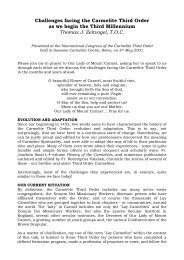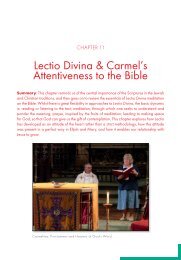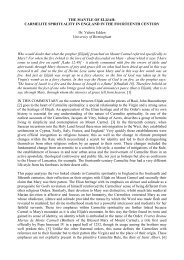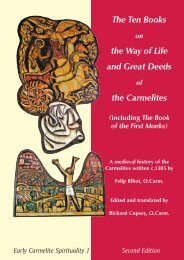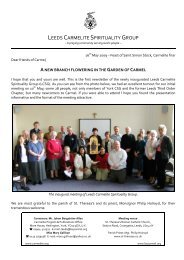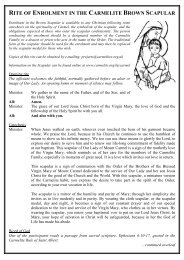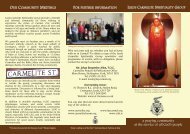Saint Albert of Trapani - British Province of Carmelite Friars
Saint Albert of Trapani - British Province of Carmelite Friars
Saint Albert of Trapani - British Province of Carmelite Friars
You also want an ePaper? Increase the reach of your titles
YUMPU automatically turns print PDFs into web optimized ePapers that Google loves.
ecause she was the mother <strong>of</strong> Christ, feudal lord <strong>of</strong> that land acquired at the<br />
cost <strong>of</strong> his blood. For this reason, and also as a choice made in the<br />
theological and ecclesial context in which Mary was a spiritual model for<br />
those who wished to commit themselves to the reform <strong>of</strong> the Church, the<br />
<strong>Carmelite</strong>s dedicated to her an oratory built in the midst <strong>of</strong> their hermitage<br />
cells. In this way they committed themselves to the service <strong>of</strong> the Virgin.<br />
In her the <strong>Carmelite</strong>s saw the new woman, obedient to the Word <strong>of</strong> God,<br />
completely devoted to discerning God’s will and carrying it out in purity and<br />
humility. In this context it was natural to contemplate the virginity <strong>of</strong> Mary<br />
and to understand it as purity: interior virtue, psychological and spiritual<br />
rather than physical. This was in fact one <strong>of</strong> the central points in the<br />
spirituality <strong>of</strong> <strong>Saint</strong> <strong>Albert</strong>. Obedience to the Word <strong>of</strong> God, which finds<br />
expression in obedience to a superior and in fraternal life, develops to the<br />
full in a pure heart, transparent to the light <strong>of</strong> God, able to contemplate the<br />
beauty <strong>of</strong> his will and to translate it freely and imaginatively in the world <strong>of</strong><br />
the everyday. The Annunciation in this context becomes one <strong>of</strong> the natural<br />
and attractive points <strong>of</strong> reference for the <strong>Carmelite</strong>s <strong>of</strong> the first generations.<br />
As a consequence, the Mother <strong>of</strong> the Lord is understood as the “most<br />
beautiful”, who best enshrines the newness brought by her Son. She is the<br />
new Gospel woman, the prototype <strong>of</strong> every Christian, the “new Eve”, true<br />
mother <strong>of</strong> all the living and <strong>of</strong> all believers. Beauty embraces all aspects <strong>of</strong><br />
Mary’s existence, for which reason she is recognised as immaculate and<br />
assumed into heaven, completely associated with the radical holiness <strong>of</strong> the<br />
Son and risen with him. It’s not strange then, that in line with the<br />
interpretation <strong>of</strong> the Church Fathers and medieval writers, the <strong>Carmelite</strong>s too<br />
recognise in the little cloud which rises from the sea at Elijah’s prayer (1<br />
Kings 18:44) an image <strong>of</strong> immaculate Mary assumed into heaven.<br />
An ancient tradition links <strong>Albert</strong> with the statue <strong>of</strong> the Madonna <strong>of</strong><br />
<strong>Trapani</strong>. It could have been carved and brought to <strong>Trapani</strong> while the saint<br />
was provincial <strong>of</strong> Sicily. It’s difficult to say what foundation this story might<br />
have, but the luminous beauty <strong>of</strong> the image <strong>of</strong> painted marble, the twist <strong>of</strong><br />
the Virgin’s body enabling her to look at the face <strong>of</strong> her child, the smile at<br />
once sweet and sad, perhaps gives us some idea <strong>of</strong> the sensibility with which<br />
<strong>Albert</strong> would have contemplated the Mother and Sister <strong>of</strong> <strong>Carmelite</strong>s. In the<br />
affectionate movement <strong>of</strong> the child towards his mother he would have<br />
recognised a reflection <strong>of</strong> his own devotion, <strong>of</strong> a love which is tender and<br />
intimate but not sentimental, but rather demanding: for one who knows how<br />
to love and venerate Mary knows that it means to commit oneself to follow<br />
her in total dedication to the plan <strong>of</strong> salvation which the Father has for<br />
humanity. To be devoted to Mary, today as in the time <strong>of</strong> <strong>Saint</strong> <strong>Albert</strong>,



